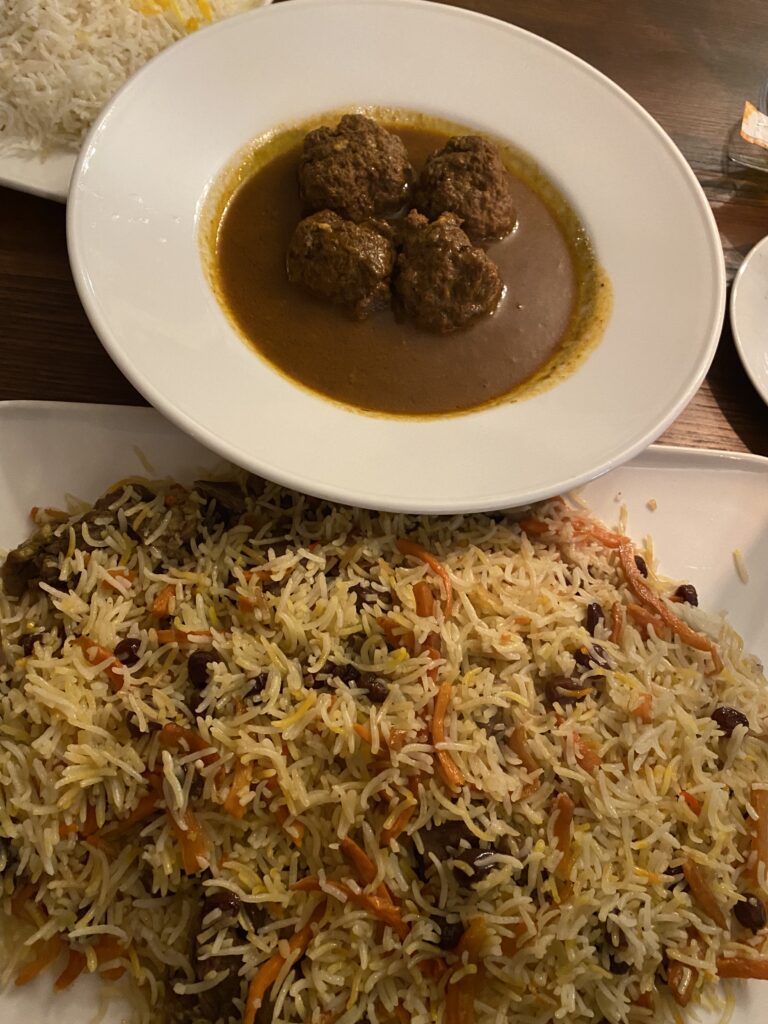Kabuli Pulao in Berlin

Kabuli Pulao in Berlin
On a mild evening in Berlin, I visited Kabul Nights restaurant in Wedding district. I was visiting Berlin for a book talk on my anthology ‘Forgotten Foods: Memories and Recipes from Muslim South Asia’. The talk was well attended with a mixture of German, Indian, Chinese, Pakistani and British audience while the moderator Razak Khan and I had a great evening discussing food stories and culinary memories. Razak invited my husband and me to dinner at the Kabul Nights restaurant. I was eager to visit the restaurant which had been mentioned in Razak’s article in Forgotten Foods anthology. The restaurant had a plush Afghani decor with traditional seating of dastarkhwan and modern setting. The proprietors from the Pakhtun area of Afghan Pakistan border are famous among the Afghan diaspora.
As Razak’s article, the evening began with the soulful rendition of Afghan singer Ahmad Zahir’s songs played specially for us. We were a group of six and decided to order a mix of Afghani dishes and share. I ordered the Kabuli pulao because I wanted to see if it really was rooted in Rampuri yakhni pulao. Kofta, seekh kababs, Bolani, chops and mantu were ordered by other guests.
Kabuli pulao was sweet and savory with the addition of sultanas and carrots to the meat and rice pulao. The rice was cooked in salty meat broth. The raisins and carrot juliennes were fried in oil with a little sugar and used as garnish. The shredded meat pieces mixed with the carrots and rice gave a unique flavour. The original yakhni pulao which we still eat in Rampur is a lightly flavoured rice and meat dish with meat broth as its base. With its journey from middle east to India along the silk route, it stopped in Afghanistan and added the plentiful dry fruits of the region. The Yarkhandi pulao is closer to Afghan pulao with the addition of dry fruits.
On its arrival in India, it found aromatic spices which were added to the meat broth. The rice was soaked overnight in salt water to give it a whitish sheen before par boiling it and cooking it in the meat broth. We decided to garnish it with fried rice.
The recipes I translated from nineteenth century cookbook manuscripts which were originally from Mughal traditions consist of a four step process. The meat broth is cooked with some spices like garlic, onions, coriander seeds, ginger, cardamoms, peppercorns, cinnamon and cloves. The meat pieces and spices are removed from the broth, and rice is marinated in it. Often the rice is first lightly boiled. The final putting together entails a frying of onions and spices to which the meat is added, a garam masala mixture is put on top and then the layer of rice. The meat stock is poured on top, and the pulao is put on dum. Rampur yakhni pulao still follows an abbreviated recipe keeping the to essential light flavour. We generally eat it with yellow chilli chutney and a curd preparation. Often kababs are a side dish to the pulao dinner.
I had eaten Kabuli pulao earlier at the Simurgh Center in Delhi prepared by the families of refugees from Afghanistan. Sometimes a lamb shrank is served with the pulao rather than shredded meat. There are no aromatic spices and fried onions which form the essential tonal quality of our pulao. Whereas I enjoyed the light sweetness mixing with the savory meat, my husband didn’t like it. Our taste buds have changed with changes in dishes. I found the sweet and savory taste somewhat like mutanjan, a sweet rice preparation with dry fruits and meatballs. The big surprise was the kofta curry which was exactly like our Indian koftas. The Afghan saffron tea, the qehwa was the final flourish to the meal.